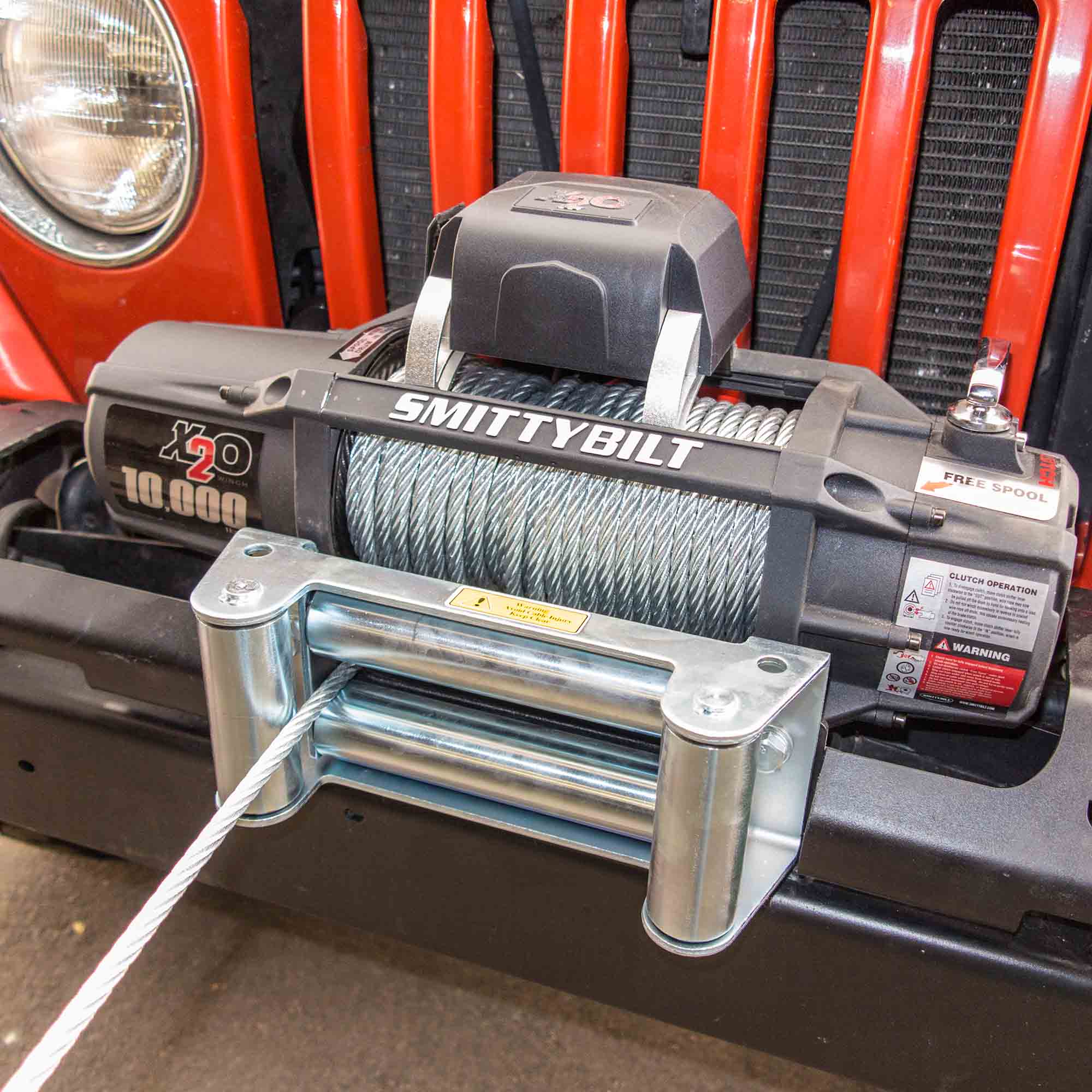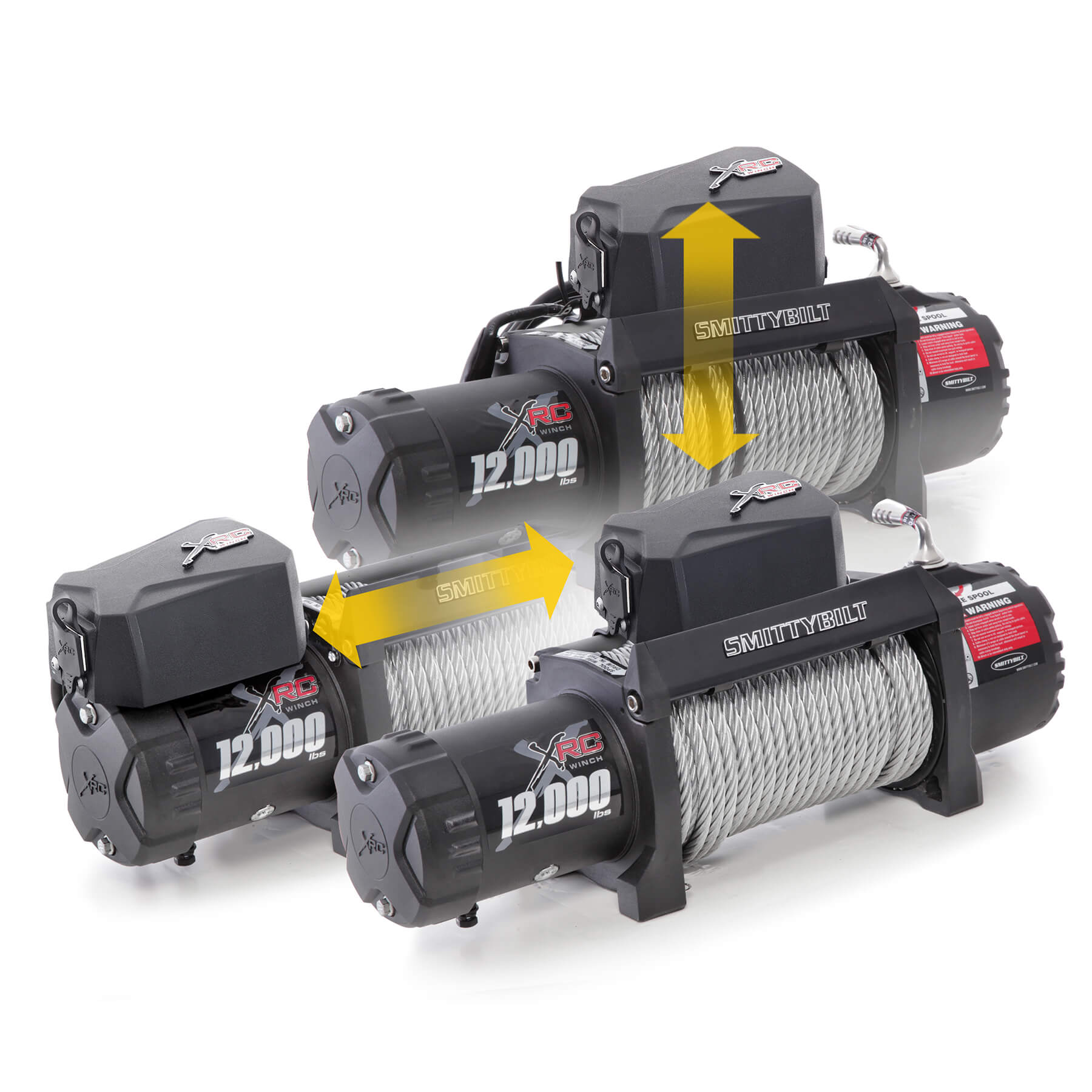|
So you've read our story on why you need a winch and are convinced that this is the next big purchase for your 4x4. Picking the right one can be a daunting process though. You can start by first determining what size winch you need. A good rule of thumb is to select a winch with a rating one and a half times higher than the weight of your vehicle. Why? There are a couple of reasons. First off, when stuck there is often drag on your rig, whether it is suction from mud or the resistance from a huge boulder you are trying to pull a differential over. Also, winches are rated for their maximum pulling power on the first wrap of cable on the drum. Each additional layer increases the diameter of the drum, so the pulling power decreases by approximately 10% per layer. It is just like larger tires change the effective gear ratio of your vehicle. Determine Your Budget Once you know what size winch you need, evaluate which models fit in your budget. Winch prices vary wildly from a few hundred dollars to well over one thousand dollars. Manufacturers, like Smittybilt and Warn, have more than one offering in popular sizes to meet your needs and your funds. The difference in price is a function of features, construction, and where the winch is made. Elements including synthetic cable, aluminum fairleads, and winch thimbles are worthwhile upgrades. If you are on a tight budget though, we would hold off on purchasing these items since they can be added in the future as funds allow.  The large clutch lever on Smittybilt winches is easy to operate, even if it is muddy or you have gloves on. You are wearing gloves when using your winch, right? The downside to the larger clutch lever is that you might need to rotate the housing on the winch body for fitment with some bumpers, but this is easily accomplished with an Allen wrench.  Warn's Zeon and Zeon Platinum winches use Albright contactors (pictured). Contactors have proven to be more resistant to water and mud and more reliable than solenoids. The VR Series of winches uses four traditional solenoids to operate the winch. The advantage of solenoids is that they are relatively inexpensive and easy to replace. Construction and Electronics Construction is not as easy to alter after the purchase as the winch cable is. More expensive winches tend to be stronger, more reliable, and more efficient as a result of better electronics, improved sealing from the elements, and higher strength materials. Smittybilt's X20 and XRC Gen2 series winches actually use the same 6.6 horsepower motor, three-stage planetary gears, and lifetime mechanical warranty. How do they differ then? The inductive braking on the X20 creates 66% less heat, making it well suited to synthetic winch line. This braking system also allows for more precise winching rather than the spool slowly coming to a stop after you release the controls. Other differences between the X20 and XRC Gen2 include a wireless remote control and increased waterproofing. Similarly, the Warn VR Series uses traditional solenoids and steel construction. The top-of-the-line Warn Zeon Platinum has contactors and aluminum end caps, tie bars, and drum to shed weight and improve corrosion resistance. The Zeon and Zeon Platinum also use larger gears than the VR series, and the gears are constructed from chromoly steel for increased strength. These are features that you cannot necessarily see from the outside, but they certainly affect the price and performance of your winch. Whether or not you will benefit from those upgrades is up to you to decide.  Pulling power is mostly a function of gearing. This Smittybilt X20 10,000-pound winch uses the same powerful 6.6 horsepower series wound electric motor as the larger X20 15,500-pound winch. But it uses 218:1 gearing while the 15,500-pound winch's gearing is nearly twice as low at 430:1. The 15,500-pound winch also uses a physically larger winch drum and larger cable (7/16-inch versus 3/8-inch).  Even the best winch on the planet can fail when you need it most if it is not installed correctly. Take care when routing the wiring for your winch. Cables should be routed away from the exhaust and sleeved anywhere they pass next to sharp edges. If you are intimidated by the installation process 4 Wheel Parts has stores all over the country with trained professionals that can install your winch for a reasonable fee. Waterproofing If your adventures often involve water and mud, buying a waterproof winch should be a priority. The IP rating (Ingress Protection) classifies and rates the degree of protection provided against the intrusion of not only water, but mud, dust, and other debris that are commonly encountered on the trail. The first number in an IP rating refers to solid particle size. Six is the highest rating and is dust tight. The second number is the resistance to liquid. Seven denotes the ability to submerge the winch up to one meter for up to 30 minutes. Eight designates the ability to continuously operate the winch in water up to three meters deep.  Put a winch accessory kit on your short list if you don't purchase one at the same time you buy your winch. This kit from Smittybilt includes a tree saver strap, a snatch block, a shackle, a short length of chain, and heavy-duty gloves in a Cordura carrying bag. The tree strap is useful for wrapping around items to secure the winch line, and the snatch block will allow you to change the direction of the pull or even double the pulling power of your winch.  While more expensive and susceptible to abrasion, synthetic winch line is lighter and safer to handle than steel cable. We recommend roller fairleads with steel cable and aluminum hawse fairleads with synthetic cable. Aluminum hawse fairleads are lighter than roller fairleads and provide a better approach angle. They also are a requirement for synthetic lines as their smoother surfaces won't fray or damage the line. Gearing Pulling power is largely a function of gearing, just like the crawl ratio of your vehicle. Smittybilt's 9,500 and 15,500 XRC Gen2 winches actually use the same powerful 6.6 horsepower series wound motor. However, the weight ratings differ significantly. This is common between winches of the same brand and model line. The difference in pulling power is that the 9,500 uses a 161:1 gear ratio, while the 15,500 uses a 397:1 gear ratio that provides more pulling power at the expense of line speed. If your winch is stalling on a short pull, adding a snatch block and attaching the cable back to your vehicle will increase the pulling power through the mechanical advantage, similar to lowering the gear ratio. This also has the added benefit of spooling more cable off the drum.  Wireless winch controllers offer the ability to operate the winch from a safe distance, and you don't have to trudge through the muck to hook them up. They do require batteries to work though and can be finicky if they do not have a strong signal. The controllers included with Smittybilt's X20 winches are the best of both worlds as they can be operated wirelessly or plugged in.  Electric winches either have an integrated solenoid pack or a separate solenoid pack like this Smittybilt XRC 12,000. Integrated packs look sleek and refined, but can have fitment issues on some vehicles and with some bumpers. The separate solenoid pack of the XRC 12,000 allows it to be mounted nearly anywhere (as long as the cables will reach) you want for fitment and ease of use. Charging Requirements Other factors that impact performance (and your budget) involve the charging system of your vehicle. Winches draw a large amount of amperage, more than the typical alternator can provide. Fortunately, we only use our winches for short periods so the battery can power the winch and then the alternator recharges the battery. Starting batteries do not like to be fully discharged repeatedly though, so consider replacing the starting battery with a deep cycle battery or adding a second battery. High-end winches are often more efficient, so you may spend more on a winch but not need to add a deep cycle battery immediately. For instance, Warn's VR8000 draws 14% more amperage than the Zeon8 (381 amps versus 335 amps at a load of 6,000 pounds). While there are a lot of factors to choosing the right winch, if you are armed with the correct information, the purchase process doesn't have to be painful. And neither does your next recovery effort!  Winches draw a large amount of amperage. Loads of 300 amps are more than the typical alternator can provide. Your vehicle's battery makes up for the difference in amperage, and the alternator recharges the battery. Deep cycle batteries, or even dual batteries, are useful upgrades if you do a lot of winching. You always want the vehicle winching to be running if possible.  If your adventures often involve water and mud, look for a winch with a minimum of an IP67 rating. An IP68 rating is even better as this denotes that the winch can be operated continuously underwater without harming it. Those who spend time in the mud often prefer steel cable to synthetic as it is not as susceptible to abrasion from the dirt. Products We Used In This Article Smittybilt Premium Winch Accessory Bag |
|